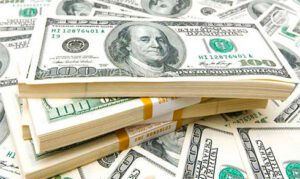
The value of the US currency against the yen jumped to a maximum since August 1990 after the Japanese Central Bank announced an unscheduled redemption of government bonds. This decision was made following the jump in the yield of 10-year Japanese government bonds above the upper limit of the Central Bank’s target range of 0.25% per annum.
The dollar against the yen soared to 149.98 yen compared to 149.9 yen at the close of the previous session.
The Bank of Japan maintains an ultra-loose monetary policy, thus seeking to support the country’s economic recovery from the effects of the COVID-19 pandemic. His policy is seriously at odds with the actions of other world central banks, raising rates to curb inflation, notes Trading Economics. This continues to put pressure on the yen and requires the Japanese Central Bank to adjust the policy of controlling the yield curve of government bonds.
The ICE-calculated index, which shows the dynamics of the dollar against six currencies (the euro, the Swiss franc, the yen, the Canadian dollar, the pound sterling and the Swedish krona), lost 0.14% on Thursday, the broader WSJ Dollar Index lost 0.05%.
The euro/dollar pair is trading at $0.9792 as of 9:15 Moscow time, compared to $0.9775 at the close of the market on Wednesday.
The pound sterling fell by this time to $1.1221 against $1.1218 the day before.
The dollar remains strong and any downward adjustments will be short-lived as long as the Federal Reserve (Fed) continues to raise the base rate, said ING analyst Francesco Pesole, quoted by Dow Jones.
The Fed’s Beige Book regional survey published on Wednesday showed that forecasts for the US economy have become more pessimistic amid growing concerns about weakening demand.
Economic activity in the country at the beginning of autumn generally slightly increased, but the situation was different in different industries and regions. Four of the twelve Federal Reserve Banks (FRB) said that activity in their districts did not change, and two reported a decrease. Negative factors were higher interest rates and inflation, as well as disruptions in supply chains.

The US dollar is getting cheaper against the euro and the pound sterling at the auctions on Monday, it is stable against the yen.
The ICE-calculated index, which shows the dynamics of the dollar against six currencies (the euro, the Swiss franc, the yen, the Canadian dollar, the pound sterling and the Swedish krona), is losing 0.29%, the broader WSJ Dollar Index – 0.27%.
The euro/dollar is trading at $0.9750 compared to $0.9722 at the market close on Friday.
The rate of the American currency against the yen is 148.72 yen against 148.75 yen following the results of the previous session.
The pound rose to $1.1272 from $1.1183. On Friday, British Prime Minister Liz Truss fired Chancellor of the Exchequer Quasi Kwarteng, appointing Jeremy Hunt to the post.
According to the Financial Times, several British Conservative MPs and prominent figures from the City of London are calling for Truss herself to step down as prime minister after controversial economic decisions that undermined her credibility.
Britain’s new finance minister told the BBC last Sunday, speaking of the possibility of winding down any of the government’s recent stimulus measures, that “nothing is out of the question.”
Later on Monday, Hunt intends to make a statement regarding the country’s medium-term budget.
The dollar rose against the yuan during trading to 7.1996 yuan from 7.1910 yuan at market close on Friday. Chinese President Xi Jinping, speaking at the 20th Congress of the Chinese Communist Party (CCP), which opened on Sunday, signaled that the country’s authorities would continue their tough policy to contain the spread of COVID-19, which has already seriously weakened the country’s economy this year.

US dollar is stable against the euro, strengthening against the yen and the pound sterling on Friday.
The ICE-calculated index, which shows the dynamics of the dollar against six currencies (the euro, the Swiss franc, the yen, the Canadian dollar, the pound sterling and the Swedish krona), adds 0.03% during trading, the broader WSJ Dollar Index loses 0.02%.
The data of the US Department of Labor published the day before showed a weaker-than-expected slowdown in inflation. The CPI rose in September by 8.2% against the same month last year – the lowest rate in seven months. Experts polled by Trading Economics predicted, on average, a slowdown in inflation to 8.1% from 8.3% in August.
Meanwhile, core inflation, excluding the cost of food and energy (Core CPI) accelerated in September to the highest since August 1982 6.6% in annual terms from 6.3% a month earlier.
Published statistical data have strengthened investors in the opinion that the Federal Reserve System (Fed) will continue the rapid tightening of monetary policy. Now traders are waiting for a sharp rise in the rate of the US Central Bank at each of the two remaining meetings of this year, Bloomberg notes.
The euro/dollar pair is trading at $0.9781 compared to $0.9780 at the close of the previous session.
The US currency against the yen is 147.45 yen against 147.22 yen at the close of the market on Thursday.
The pound fell to $1.1322 from $1.1331 the day before.
British Treasury Secretary Kwazi Kwarteng left Washington, where he was meeting with representatives of the International Monetary Fund (IMF), a day earlier than planned. Experts believe that he may abandon part of the tax cuts he announced earlier in order to prevent an economic crisis in the country, the Financial Times writes.
The newspaper’s sources note that the IMF and finance ministers of several other countries recommended that he quickly abandon plans for tax cuts in order to avoid financial problems in the economy.

The dollar is moderately declining against the euro, but growing against the Japanese yen, renewing its maximum value in 24 years.
The ICE-calculated index, which shows the performance of the US dollar against six currencies (the euro, Swiss franc, yen, Canadian dollar, pound sterling and the Swedish krona), is practically unchanged on Wednesday morning, as is the broader WSJ Dollar.
The euro/dollar pair is trading at $0.9721 by 8:52 p.m. compared to $0.9707 at the close of the session on Tuesday, the euro adds about 0.1%.
Meanwhile, the rate of the American currency against the yen rose by almost 0.3% and amounted to 146.25 yen compared to 145.86 yen the day before. This is the highest rate since August 1998. The last time the yen fell to a 24-year low at the end of September, after which the Japanese Ministry of Finance intervened in the foreign exchange market to support the national currency.
The dollar is strengthening against the yen due to mixed monetary policy rates: while the Fed is actively raising interest rates, the Bank of Japan continues to adhere to extremely soft monetary policy.
The pound rose 0.4% to $1.1012 compared to $1.0968 at the close of the previous session.
Traders are evaluating conflicting signals about the Bank of England’s emergency government bond purchase program.
British Central Bank Chairman Andrew Bailey said that the regulator will complete the purchase of bonds on Friday, as planned. “The essence of interventions to stabilize financial markets is partly that this is a temporary phenomenon,” he said.
However, the Financial Times then wrote, citing three anonymous sources, that the Central Bank privately hinted to representatives of some banks about the possibility of extending the bond purchase program in order to protect UK pension funds from losses.

The US dollar is moderately declining against major world currencies on Thursday morning, investors evaluate the statements of the Federal Reserve Board and statistical data.
The ICE-calculated index, which shows the dynamics of the US dollar against six currencies (the euro, the Swiss franc, the yen, the Canadian dollar, the pound sterling and the Swedish krona), is down 0.2%, the broader WSJ Dollar is down 0.25%.
The euro/dollar pair is trading at $0.9920 by 9:08 Moscow time compared to $0.9885 at the close of the session on Wednesday, the euro adds about 0.35%.
The exchange rate of the American currency against the yen is reduced by 0.1% and amounts to 144.53 yen compared to 144.69 yen the day before.
The pound rose 0.1% to $1.1335 compared to $1.1327 at the close of the previous session.
The day before, the head of the Federal Reserve Bank of Atlanta, Rafael Bostic, said that he supports raising the key interest rate in the US by another 125 basis points by the end of the year, to 4.5%.
Meanwhile, San Francisco Fed colleague Mary Daly told CNN that the central bank should raise borrowing costs even higher and keep them high until inflation starts approaching 2%.
It became known yesterday that the index of business activity in the US services sector (ISM Non-Manufacturing) in September decreased to 56.7 points compared to 56.9 points a month earlier, data from the Institute of Supply Management (ISM) showed. Analysts, on average, assumed a more significant drop, to 56 points, according to Trading Economics.
Now all the attention of market participants is directed to data on the US labor market, which will be published on Friday. Experts believe that the unemployment rate in the country in September remained at the August mark of 3.7%, and the number of new jobs increased by 315 thousand people.

The dollar strengthens against the euro, yen and pound sterling in trading on Wednesday after a sharp decline the day before amid signals of a gradual decline in activity in the US economy.
Investors are waiting for data on the US labor market, which is expected to show a slowdown in job growth in the country. The consensus forecast of experts surveyed by Market Watch suggests that the number of jobs in September increased by 275 thousand (315 thousand in August), while maintaining unemployment at 3.7%.
The US Department of Labor will release the data on Friday at 3:30 p.m.
Another report from the Department of Labor, which was published on Tuesday, showed a sharp decrease in the number of open vacancies in the States in August. The indicator fell by 10% – the fastest pace since the start of the pandemic in 2020, to 10.1 million vacancies.
Weak statistics on the US economy are a good signal for risk appetite, as they speak in favor of a reduction in the trajectory of the Federal Reserve (Fed) rate hike, said Steven Innes, managing partner at SPI Asset Management.
Some “cooling” of the labor market will help ease inflation in the US and may reduce the need for further sharp tightening of monetary policy by the Fed, writes Dow Jones.
“If this trend continues, the Fed may back off somewhat in terms of rate hikes later this year and early next year,” said Jack Janasiewicz, portfolio manager at Natixis Investment Managers Solutions.
The euro/dollar pair is trading at $0.9966 on Wednesday, compared to $0.9987 at the close of previous trading. The pound fell to $1.1435 from $1.1475 at the close of previous trading.
The US dollar against the yen is 144.25 yen against 144.14 yen the day before.
On Tuesday, the dollar lost 1.7% against the euro, 1.4% against the pound and 0.3% against the yen.